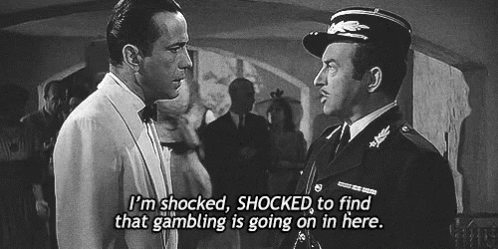This week, a federal court found one of the laws most commonly used to charge undocumented immigrants with crimes is unconstitutional because it's too racist.
This is a HUGE decision; it's a true landmark in American jurisprudence, which actually has entire doctrines about how courts should bend over backwards to give deference to bigoted lawmakers. ("Good faith," my ass.)
So here's how we got here: In 2020, Gustavo Carrillo-Lopez was indicted for the felony of illegally re-entering the United States after being deported. His lawyers filed a motion to dismiss the charge, arguing the law he was charged under is racist. Specifically, Carrillo-Lopez argued the law was both "enacted with a discriminatory purpose" and "has a disparate impact on Latinx persons."
A look at history and statistics shows that this is clearly true. But, generally, no matter what the evidence, courts will do whatever they can to find racist laws constitutional.
That's what makes it so incredible that Chief US District Judge Miranda Du agreed with Carrillo-Lopez, ruling the law making re-entry a felony "was enacted with a discriminatory purpose and that the law has a disparate impact on Latinx persons, and the government fails to show that Section 1326 would have been enacted absent racial animus" and dismissing the charges.
Badass, Judge Du.

Part 1: Congress Is Super Racist
Getting a court to find a law unconstitutional because of racism is really hard to do, especially when that law has been on the books for either 92 or 69 years, depending on how you parse it. As Judge Du laid out, to prevail, Carrillo-Lopez had to demonstrate both that the law had a "disparate impact" on Hispanic/Latino immigrants and that "racially discriminatory intent or purpose" was a "motivating factor in the decision" to enact the law. He did just that.
Section 1326 (8 U.S.C. § 1326) is the part of US immigration law that makes it a felony for someone who was deported to re-enter the country. It's been on the books since 1929, was re-authorized in 1952, and is commonly used against undocumented immigrants like migrant workers who enter and exit the US more than once.
A look at the history of this law shows it is, in fact, racist — as it was always intended to be. The legislative history from 1929 is so bad that, eventually, even the government conceded that "discriminatory intent motivated [its] passage[.]"
The " Undesirable Aliens Act of 1929, " as you may be able to tell from the name, was passed specifically with white supremacy and bigotry in mind. This was the first time border-crossing was criminalized. Like professors Benjamin Gonzalez O'Brien from San Diego State University and Kelly Lytle Hernandez of UCLA explained to the court,
the legislation came on the heels of the National Origins Act of 1924 which narrowed the pathways of legal immigration by reserving 96 percent of all quota slots for European immigrants and emphasized how racial animus became more intense heading into the 1920s, a period referred to as the 'Tribal Twenties,' when nativism and eugenics became more widely accepted and began to impact Congressional immigration proposal.
(Note: From here on out, I'm taking internal citations and quotation marks out, for your reading pleasure.)
The provision making it a crime was reenacted and strengthened with the McCarran–Walter Immigration and Nationality Act of 1952. And guess what? Congress was racist then, too. Or, as Judge Du put it, "[t]he 1952 reenactment did not cleanse Section 1326 of its racist origins and was also motivated by discriminatory intent."
Supporters of Section 1326 actually used the slur "wetback" in Congress while making it easier to prosecute people for illegal re-entry. On behalf of the Department of Justice, Deputy Attorney General Peyton Ford praised the change, saying it would "aid in taking action against the conveyors and receivers of the 'wetback."' Another supporter said legislation must make it easier "to deal more effectively with the wetback problem[.]" The same Congress also passed another anti-immigration bill that was officially nicknamed the "Wetback Bill," also criminalizing certain border crossings.
President Truman vetoed the McCarran–Walter Act because of its fuckery, calling it "legislation which would perpetuate injustices of long standing against many other nations of the world" and "intensify the repressive and inhumane aspects of our immigration procedures." Congress overrode his veto.
It's pretty damn racist, guys.
The totality of evidence shows that the same factors motivating the passage of Section 1326 in 1929 were present in 1952. Not only did Congress fail to repudiate the racial animus clearly present in 1929, but it expanded the government's power to enforce unlawful reentry, despite President Truman's call to reimagine immigration laws. The 1952 Congress incorporated the advice of supporters of the bill who used racial epithets in official documents, while contemporaneously passing another bill targeting "wetbacks." Although it is "not easy" to prove that racism motivated the passage of a particular statute, the Court reasons that it cannot be impossible, or Arlington Heights would stand for nothing.
For more on the racist history behind our immigration laws, check out " Behind the Criminal Immigration Law: Eugenics and White Supremacy " by Ian MacDougall at ProPublica.
Part 2: Racist Law Is Used in Racist Way
It's not just that Section 1326 was intended to be racist — it's racist in its application, too. Like Judge Du found, "Section 1326 does indeed disparately impact Mexican and Latinx individuals." As Professor Hernández testified, between 1929 and 1952, "some years, Mexicans comprised 99 percent of immigration offenders" and by the 1930s, "tens of thousands of Mexicans had been arrested, charged, prosecuted, and imprisoned for unlawfully entering the United States."
Currently available data shows that trend has, unsurprisingly continued.
"While no publicly available data exists as to the national origin of those prosecuted under Section 1326, over 97% of persons apprehended at the border in 2000 were of Mexican decent, 86% in 2005, and 87% in 2010."
The government argued that it was fine if Section 1326 was racist in application, because we just really like to over-police our southern border. Judge Du rightly called out this argument as "circular and inconclusive," writing:
It cannot be the case that the mere over-policing of certain locations—here the Southern border as opposed to the Northern border—prevents a specific group from raising equal protection challenges. Or that because Mexican citizens will likely make up more unlawful reentries because they are a higher percentage of the overall illegal alien population, they cannot raise equal protection challenges. Ultimately, the law still bears more heavily on those individuals than others[.]"
I don't know about you, but I am shocked, JUST SHOCKED, that an American immigration law would primarily be used to punish people from Mexico, Central, and South America.

Part 3: Finally Recognizing That Racist Law Is Racist
Given her background, Judge Du's decision is also a reminder of how important it is to have people on the federal branch who come from different backgrounds. For decades, old white men who have no personal experience with the US immigration system have been ruling, basically, "It's fiiiiiiiiiiiiiiiine," when dealing with laws that we all know have been racist this entire time.
Judge Du is, herself, an immigrant who fled Vietnam as a child. Perhaps her lived experience helped her to look at Section 1326 with a fresh eye. Americans like me, who were born here, have basically just always known that our immigration laws are racist. It's beyond refreshing to see the racist history of our immigration laws finally called out by a federal judge.
Judge Du recognized just how historic this ruling is.
The Court is aware that proving discriminatory intent motivated the passage of a specific statute is difficult—in fact, unprecedented. But despite the high threshold, the Court cannot deny that when considered as a whole, the evidence indicates discriminatory intent on the part of the 1952 Congress.
And, in the end, the judge found that the government "failed to establish that a nondiscriminatory motivation existed in 1952 for reenacting Section 1326 that exists independently from the discriminatory motivations, in either 1929 or 1952." And that's not all!
Moreover, the government's alternative arguments—that a nondiscriminatory motive was "plain" or that subsequent amendments somehow imply the racial taint was cleansed—are not supported by caselaw nor borne out by the evidentiary record.
What happens next remains to be seen. The DOJ hasn't said yet whether it plans to appeal, but it almost certainly will. And, if Judge Du's opinion survives the Ninth Circuit, the Supreme Court is almost certain to not only reverse, but to make it even harder to win these kinds of cases. But this is the kind of case that's important not just for its current impact, but also for the impact it has in the future. Someday, this case will be cited by immigrants' rights activists the same way we now cite Justice Frankfurter's dissent in Korematsu .
And, as for my preferred outcome, I'm with Ian Milhiser : The DOJ should refuse to appeal and be legends.
Here's the opinion. It's wonderful.
Follow Jamie on Twitter!
[ 9th Cir. / ProPublica / 8 U.S.C. § 1326 ]
Do your Amazon shopping through this link, because reasons .





And if white folks did harvest our food, half the population wouldn't be able to afford it.
Really? In Texass and Alabama I can get thrown in jail and the school district will lose all its money for pointing out that Mexico just left the Chicano community high and dry in the 1840s.
Talk to a 6th generation Mexican American in Los Angeles County.
They don't want to be part of Mexico. They hate mexico (the nation not the people) more than Tucker Carson